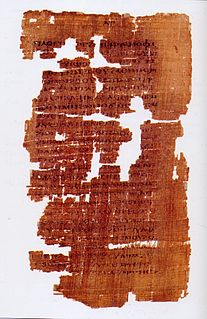
Apocrypha are works, usually written, of unknown authorship or of doubtful origin. Biblical apocrypha is a set of texts included in the Latin Vulgate and Septuagint but not in the Hebrew Bible. While Catholic tradition considers some of these texts to be deuterocanonical, Protestants consider them apocryphal. Thus, Protestant bibles do not include the books within the Old Testament but have often included them in a separate section, usually called the Apocrypha. Other non-canonical apocryphal texts are generally called pseudepigrapha, a term that means "false attribution".

The Bible is a collection of sacred texts or scriptures. Varying parts of the Bible are considered to be a product of divine inspiration and a record of the relationship between God and humans by Christians, Jews, Samaritans, and Rastafarians.

The New Testament is the second part of the Christian biblical canon, the first part being the Old Testament, based on the Hebrew Bible. The New Testament discusses the teachings and person of Jesus, as well as events in first-century Christianity. Christians regard both the Old and New Testaments together as sacred scripture. The New Testament has frequently accompanied the spread of Christianity around the world. It reflects and serves as a source for Christian theology and morality. Extended readings and phrases directly from the New Testament are incorporated into the various Christian liturgies. The New Testament has influenced religious, philosophical, and political movements in Christendom and left an indelible mark on literature, art, and music.

The Vulgate is a late-4th-century Latin translation of the Bible that became the Catholic Church's officially promulgated Latin version of the Bible during the 16th century. The translation was largely the work of Jerome, who in 382 had been commissioned by Pope Damasus I to revise the Vetus Latina Gospels then in use by the Roman Church. Jerome, on his own initiative, extended this work of revision and translation to include most of the books of the Bible, and once published, the new version was widely adopted and eventually eclipsed the Vetus Latina; so that by the 13th century, it had taken over from the former version the appellation of versio vulgata or vulgata for short, and in Greek as βουλγάτα ("Voulgata").

Imereti is a region in Georgia situated along the middle and upper reaches of the Rioni River.

The Bible has been translated into many languages from the biblical languages of Hebrew, Aramaic and Greek. As of October 2017 the full Bible has been translated into 670 languages, the New Testament has been translated into 1,521 languages and Bible portions or stories into 1,121 other languages. Thus at least some portion of the Bible has been translated into 3,312 languages.

Partial Bible translations into languages of the English people can be traced back to the late 7th century, including translations into Old and Middle English. More than 450 translations into English have been written.

The Old English Bible translations are the partial translations of the Bible prepared in medieval England into the Old English language. The translations are from Latin texts, not the original languages.

Middle English Bible translations (1066-1500) covers the age of Middle English, beginning with the Norman conquest and ending about 1500. Aside from Wycliffe's Bible, this was not a fertile time for Bible translation. English literature was limited because French was the preferred language of the elite, and Latin was the preferred literary language in Medieval Western Europe.

The Peshitta is the standard version of the Bible for churches in the Syriac tradition.

The Syriac Infancy Gospel is one of the texts among the New Testament apocryphal writings concerning the infancy of Jesus. It may have been compiled as early as the sixth century, and was partly based on the Infancy Gospel of Thomas, and Protevangelium of James.

The Gothic Bible or Wulfila Bible is the Christian Bible in the Gothic language spoken by the Eastern Germanic (Gothic) tribes in the early Middle Ages.
The Four Gospels may refer to:

Syria played an important or even predominant role in the beginning of Christianity. Here is where the Gospel of Matthew, the Gospel of Luke, the Didache, Ignatiana, and the Gospel of Thomas were written. Syria was the country in which the Greek language intersected with the Syriac, which was closely related to the Aramaic dialect used by Jesus and the Apostles. That is why Syriac versions are highly esteemed by textual critics. Scholars have distinguished five or six different Syriac versions of all or part of the New Testament. It is possible that some translations have been lost. The Manuscripts originate in countries like Lebanon, Egypt (Sinai), Mesopotamia, Assyria, Armenia, Georgia, India, and even from China. This is good evidence for the great historical activity of the Syriac church.

Bible translations in the Middle Ages discussions are rare in contrast to Late Antiquity, when the Bibles available to most Christians were in the local vernacular. In a process seen in many other religions, as languages changed, and in Western Europe languages with no tradition of being written down became dominant, the prevailing vernacular translations remained in place, despite gradually becoming sacred languages, incomprehensible to the majority of the population in many places. In Western Europe, the Latin Vulgate, itself originally a translation into the vernacular, was the standard text of the Bible, and full or partial translations into a vernacular language were uncommon until the Late Middle Ages and the Early Modern Period.

A biblical canon or canon of scripture is a set of texts which a particular religious community regards as authoritative scripture. The English word "canon" comes from the Greek κανών, meaning "rule" or "measuring stick". Christians became the first to use the term in reference to scripture, but Eugene Ulrich regards the idea as Jewish.

The canon of the New Testament is the set of books Christians regard as divinely inspired and constituting the New Testament of the Christian Bible. For most, it is an agreed-upon list of twenty-seven books that includes the Canonical Gospels, Acts, letters of the Apostles, and Revelation. The books of the canon of the New Testament were written before 120 AD.
The history of all Bible translations into Slavic languages begins with Bible translations into Church Slavonic. Other languages include:














